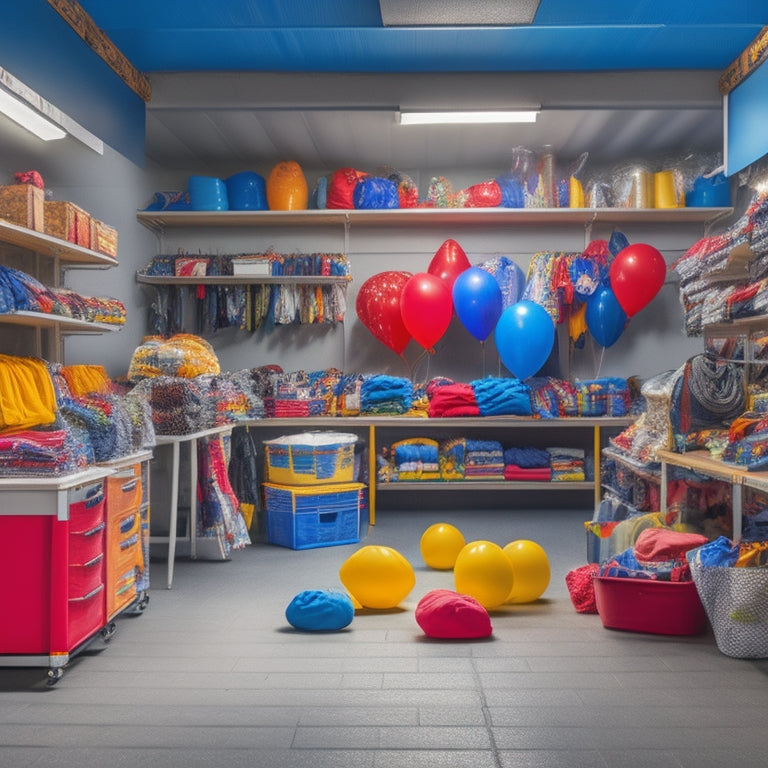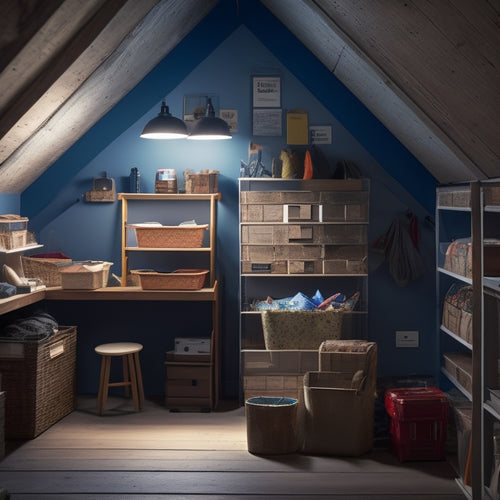
Streamline Your Space for a Profitable Garage Sale
Share
You're one strategic garage sale away from decluttering your home, making some extra cash, and enjoying a more organized living space. To get started, evaluate unwanted items by gauging their utility and letting go of emotional attachments. Next, categorize and group similar items together, and assign prices based on market value and item condition. Create an organized sales floor by grouping similar items together and designating high-demand areas. Finally, display items effectively with eye-catching displays and clear pricing. By following these steps, you'll be well on your way to a profitable garage sale – and there's even more to discover that'll help you maximize your success.
Key Takeaways
• Purge unwanted items first to declutter and assess their utility, letting go of emotional attachments and considering donations or sales.
• Categorize and group similar items together for easy browsing, using a labeling system and creating inventory themes for visual appeal.
• Assign prices to each item based on market research, considering condition, rarity, and demand, and clearly displaying prices for customers.
• Organize the sales floor by grouping similar items together, designating high-demand areas, and using shelf labels and bargain bins for clear navigation.
• Display items effectively using eye-catching displays, themed sections, and visual elements like risers and shelves to attract customers and encourage sales.
Purge Unwanted Items First
What's holding you back from a profitable garage sale: the clutter that's been piling up in your garage or storage spaces for years? It's time to face the music and get rid of the items that are no longer serving you.
Purging unwanted items is essential to a successful garage sale. Start by going through each item and asking yourself if you really need it or if it's just taking up space. Be honest with yourself - if you haven't used it in the past year, it's probably safe to get rid of it.
Let go of emotional attachment to items that hold sentimental value. Consider donating gently used items to charity or selling them online. Donation options like Goodwill, Habitat for Humanity, or local thrift stores can give your items a second life. You'll not only declutter your space but also support a good cause.
Categorize and Group Similar Items
Now that you've purged your unwanted items, it's time to categorize and group similar items together, making it easier for customers to find what they're looking for. This step is essential in creating a well-organized and profitable garage sale.
Start by grouping items into categories, such as clothing, household items, toys, and books. Within each category, create subgroups based on specific characteristics, like women's clothing, kitchen utensils, or children's toys. This will make it easy for customers to navigate your sale and find what they're looking for.
Implement a labeling system to further categorize your items. Use signs, stickers, or labels to indicate the category and subgroup of each item. This will also help you keep track of your inventory and identify which items are selling well.
Consider creating inventory themes, such as a 'kitchen corner' or a 'kids' zone,' to create a visually appealing and engaging shopping experience. By categorizing and grouping similar items together, you'll create a seamless shopping experience for your customers, increasing the chances of selling more items and making a profit.
Assign Prices to Each Item
You'll need to determine the prices for each item, considering factors such as original price, condition, and demand to make sure you're competitive and profitable. This is where price psychology comes into play. You want to set prices that are attractive to customers without sacrificing your profit margin.
Start by researching similar items online to gauge their market value. Then, adjust your prices based on the item's condition, rarity, and demand. Be mindful of sticker shock, where high prices can deter customers from making a purchase. Aim for a balance between profitability and customer appeal.
Organize your items into categories, such as 'high-demand' and 'bargain bin,' to help you set prices quickly and efficiently. Use stickers or labels to clearly display prices, making it easy for customers to find what they're looking for.
Create an Organized Sales Floor
Transform your garage sale into a shopper's paradise by deliberately arranging your merchandise into visually appealing sections, making it easy for customers to navigate and find the treasures they're looking for. A well-planned floor plan is critical to creating an organized sales floor. Start by grouping similar items together, such as books, clothes, and household items. This will make it easy for customers to find what they're looking for.
To take your organization to the next level, consider the following:
-
Designate a 'high-demand' area: Place popular items like kids' toys, baby gear, and electronics in a prominent area to attract customers.
-
Use shelf labels: Clearly label each shelf or section with its contents, making it easy for customers to find specific items.
-
Create a 'bargain bin': Designate a section for discounted or clearance items to attract price-conscious customers.
- Leave space to breathe: Make sure there's enough space between sections for customers to move comfortably and easily access items.
Display Items to Sell Effectively
By thoughtfully arranging your items, you can create an irresistible display that draws customers in and encourages them to buy. To do this, focus on creating eye-catching displays that showcase your best or most unique items.
Group similar items together, and consider creating themed sections, such as a 'kids' corner' or a 'vintage collectibles' area. This will help create a sense of shopper flow, guiding customers through your sale and encouraging them to explore more.
Pay attention to the visual appeal of your displays, using risers, tables, and shelves to create visually appealing layers. Hang clothes and linens on racks or use mannequins to create a boutique-like atmosphere.
Don't overcrowd your displays – leave some breathing room to make it easy for customers to browse. Finally, make sure your prices are clearly marked and easy to read, so customers can quickly see the value of each item.
Frequently Asked Questions
Can I Have a Garage Sale During a Rainy or Winter Season?
"Imagine a sea of poncho-clad Winter shoppers splashing through puddles to snag your deals on Rainy days. But, honestly, can you really expect a crowd during the off-season? Probably not, so plan accordingly and adjust your sale's timing."
How Do I Handle Early Birds Who Want to Start Shopping Early?
You'll encounter early birds wanting to start shopping before the official start time. Establish bird etiquette by politely telling them you're not offering early access, and stick to your scheduled hours to maintain a stress-free sale.
Should I Accept Credit Card Payments or Only Cash?
"Ah, you want to alienate customers by only accepting cash? Don't be a dinosaur! You'll thrive with mobile payments and card readers, making it easy for shoppers to spend their hard-earned cash on your awesome deals."
Can I Sell Homemade Food or Baked Goods at My Garage Sale?
You're wondering if you can sell homemade food or baked goods at your sale. Check local Food Safety regulations first, then consider it as a unique Sales Strategy to attract more customers and increase profits.
Do I Need to Obtain a Special Permit or License for a Garage Sale?
Imagine a sunny day, your garage sale in full swing, when suddenly, authorities arrive, inquiring about permits. Don't let this scenario unfold; research your local sale requirements and neighborhood restrictions to determine if you need a special permit or license.
Related Posts
-

Unlock Attic Storage Potential With Online Guides
You're sitting on a treasure trove of storage space, right above your head! Reveal your attic's hidden potential by a...
-

Simplify and Streamline Your Small Entryway Chaos
You're ready to tame the chaos in your small entryway! Start by gathering three labeled boxes to categorize clutter, ...

